Playbook for Pub 946: How to Depreciate Property
- Greg Pacioli

- Feb 6
- 4 min read
Updated: Jul 28

Here's the thing about depreciation: it's the tax code's way of acknowledging that everything we build, buy, or develop eventually wears out. Depreciation is a story about time, value, and the natural order of an asset's life. IRS Publication 946 isn't just another government document filled with rules and regulations; it’s actually a guide that helps us understand how our business assets age and how the tax system acknowledges this unavoidable decline.
Think about your smartphone. The moment you unbox it, it starts losing value. Now multiply that concept across every every building, every piece of equipment, every fixture in the real estate world.
That's what Pub 946 tackles... the when, how, and why of accounting for this decay in value. It’s the IRS’s way of trying to bring some order to the chaos, creating a standard for how we measure and account for the depreciation of business assets.
Download PDF >> Publication 946
Core Concepts & Framework of the Publication
The publication begins by establishing fundamental concepts that serve as building blocks for understanding depreciation. It carefully explains what property can be depreciated, who can claim depreciation, and when depreciation begins and ends. A key insight offered is the distinction between improvements versus repairs, as this differentiation significantly impacts tax treatment.

The Modified Accelerated Cost Recovery System (MACRS)
At the heart of Pub 946 lies the explanation of MACRS, the current depreciation system used for most property. The publication expertly breaks down both the General Depreciation System (GDS) and Alternative Depreciation System (ADS), explaining when each should be used. Particularly valuable is the detailed discussion of recovery periods for different types of property, from office furniture to commercial buildings.
Section 179 & Bonus Depreciation
The publication provides comprehensive coverage of Section 179 expensing and bonus depreciation, two powerful tax-planning tools. It details the annual limits, phase-out thresholds, and qualifying property types. The interaction between these provisions is thoroughly explained, helping readers optimize their depreciation strategy.
Listed Property & Special Rules
A significant portion addresses listed property - items that require special attention due to their potential personal use. The publication clarifies recordkeeping requirements and usage tests that must be met for these items. The special rules for vehicles, particularly luxury automobiles, are meticulously detailed with specific dollar limitations.
Property Classes & Recovery Periods
The document includes extensive tables categorizing different types of property into appropriate classes with corresponding recovery periods. This section proves invaluable for determining the correct depreciation timeline for various assets, from agricultural equipment to utility properties.
Real Property Considerations
The treatment of real property receives special attention, with detailed explanations of depreciation periods for residential rental property, commercial buildings, and land improvements. The publication clarifies the different treatment of structural components versus personal property within a building.
Practical Examples & Worksheets
Throughout the publication, practical examples illustrate complex concepts, while worksheets guide readers through necessary calculations. These tools help translate theoretical concepts into practical application, particularly valuable for computing depreciation under various scenarios.
Retirement & Disposition Rules
The publication concludes with comprehensive coverage of what happens when property is retired or disposed of, including rules for recapture of depreciation upon sale and how to handle casualties and thefts.
Analysis & Significance
Pub 946's importance extends beyond its role as a technical manual. It serves as a crucial tool for tax planning and compliance, helping businesses optimize their tax positions while maintaining compliance with IRS regulations. The publication's detailed treatment of various scenarios reflects the complexity of modern business assets and operations.
Areas for Improvement
While comprehensive, the publication could benefit from more real-world case studies, particularly involving emerging technologies and modern business assets. Additionally, some sections could be more clearly organized to help readers navigate the complex interplay between different depreciation provisions.
Conclusion
In the end, Publication 946 is more than just a manual; it provides a unique perspective on the lifecycle of business assets. It tells a story about aging, how we account for it, and how we can make smart choices in a world where everything eventually needs to be replaced.
The real value of this publication goes beyond its technical accuracy (which is important) or its comprehensive coverage (and it truly is thorough). What makes it shine is its commitment to creating a shared language for discussing how value depreciates over time.
This framework empowers businesses of all sizes to plan, invest, and grow with a unified understanding of how the tax system impacts their investments.
So, the next time you browse through its pages or navigate its digital format, keep in mind: you’re not merely looking at depreciation schedules and recovery periods. You’re engaging with a tax system that recognizes the essential truth that every business asset has a lifecycle, and grasping that lifecycle is crucial for making wiser decisions about when to invest, when to replace, and how to expand.
No need to comprehend all 100+ pages of Publication 946. But ask yourself and your advisor...
What are you prepared to incorporate into your investment strategy?
Join Our Mailing List 📩
Stay connected with our newsletter and be the first to hear the latest from Find Cost Seg. We promise to flood your inbox and only send you the updates that matter!



Comments